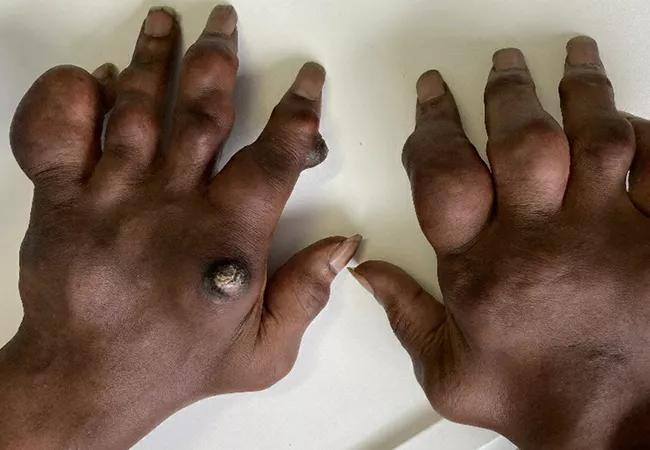Multidisciplinary care may help clear barriers to treatment

By James Vondenberg, DO, Vishwanath Ganesan, MD, and Ahmed Elghawy, DO
Advertisement
Cleveland Clinic is a non-profit academic medical center. Advertising on our site helps support our mission. We do not endorse non-Cleveland Clinic products or services. Policy
CASE
A 43-year-old-male was admitted to Cleveland Clinic for gout flare. The patient, who lives alone, had a history of coronary artery disease post-percutaneous coronary intervention, hyperlipidemia, schizophrenia and long-standing, severe polyarticular and tophaceous gout.
At age 21, the patient had been diagnosed with rheumatoid arthritis and had symptoms of inflammatory polyarthritis. This diagnosis was questioned when he was being established at Cleveland Clinic, where a repeat workup demonstrated a negative rheumatoid factor and cyclic citrullinated peptide.
His exam was notable for multiple open tophi, confirming a diagnosis of polyarticular tophaceous gout. Over several years, the patient was trialed on multiple medications, including allopurinol, probenecid, febuxostat, colchicine, pegloticase, anakinra and prednisone. He frequently missed appointments. His response to these therapies, both independently and in combination, has been difficult to assess because of significant psychiatric and socioeconomic barriers that contribute to medication non-adherence.
Physical exam was notable for tophaceous deposits involving bilateral hands, forearms, elbows, ankles, feet, shins and knees, in addition to deposits of the musculature and tendons of the upper and lower extremities. Laboratory findings were notable for elevated uric acid and C-reactive protein. Radiographs of the feet, tibia/fibula, knees, ankles and forearms revealed extensive changes of tophaceous gout.
A re-trial of pegloticase was discussed, but the patient expressed concerns that pegloticase had caused him to have a seizure in the past, so he declined. Thorough review of the medical records confirmed that his seizure had been during a hospital admission for pneumonia. The patient received anakinra for his flare and was followed closely.
Advertisement
During outpatient follow-up for injection teaching, the patient disclosed that he had not refrigerated his anakinra for several weeks. He reported that he was living alone without family nearby and was unable to care for himself. His vital signs at that time were further concerning for hypertensive crisis, for which he was sent to the emergency department.
Over the next few weeks, specialists in social work, adult psychology, pharmacology and rheumatology worked to improve the patient’s access to care and medication education. At his most recent follow-up, the patient noted improved symptoms and pain control with daily anakinra injections and allopurinol 900 mg daily as urate-lowering therapy; he noted that he was now properly storing his anakinra.
The patient is currently engaged in therapy with adult psychology clinicians, and strides are being made with social work to provide home assistance in addition to easier transportation and access to care.
Here, we have a male in his 40s with schizophrenia and gout that has been uncontrolled and progressing throughout his lifetime. He experienced no response to multiple therapies because of medication nonadherence and inconsistent follow-up. While his physical exam indicates significant progressive disease, this is likely a consequence of the numerous difficulties the patient faced before receiving multidisciplinary care at Cleveland Clinic.
Mental health can often be a significant barrier to care for patients struggling with rheumatic disease. In this patient’s case, schizophrenia and limited health literacy hindered control of his disease. For example, the patient’s delusions regarding previous treatment with pegloticase made this option difficult to consider even though he may have been an ideal candidate for it.
Additionally, the patient may have not had the medical competence to fully appreciate the severity of his disease and how vital his medications were to treatment. By collaborating with colleagues in adult psychology, our team was able to communicate regularly and effectively to ensure that the patient fully understood his treatment. Although this is an ongoing process, the foundation of medical care that was missing for years has finally been built.
Advertisement
When treating patients with rheumatic disease, a multidisciplinary focus can help overcome social and economic factors that would otherwise impede or complicate medical care. This patient’s economic barriers had made getting to appointments a major task. Financial difficulties and inconsistent modes of transportation resulted in missed appointments and inability to continue medications that would treat his rheumatic disease. A combination of polypharmacy and multiple hospitalizations with medication changes often led to the patient experiencing confusion regarding his treatment plan.
Without a trusted guardian to aid in his medical decision-making, ensuring consistent medical care was difficult. Collaborating with social work has provided him with tools to help him properly use his medication and to participate in outpatient followup. The combination of this patient’s socioeconomic challenges with his psychiatric history creates a situation with limited treatment options.
Our multi-team approach has given this patient a better opportunity to understand the full extent of his disease and take steps to effectively treat it. Caring for such patients serves as a sobering reminder that, even with the best therapies available, mental health and socioeconomic obstacles can delay or hinder medical care altogether. At times, the start of therapy must come second to forming a solid therapeutic relationship with our patients.
Advertisement
Advertisement

Unraveling the TNFA receptor 2/dendritic cell axis

Nasal bridge inflammation, ear swelling and neck stiffness narrow the differential diagnosis

Genetic testing at Cleveland Clinic provided patient with an updated diagnosis

From dryness to diagnosis

Multiple comorbidities are associated with pediatric psoriasis

Untreated seropositive erosive RA led to peripheral ulcerative keratitis

New clinic meets Hispanic patients where they are

Experienced clinicians can bridge traditional care gap